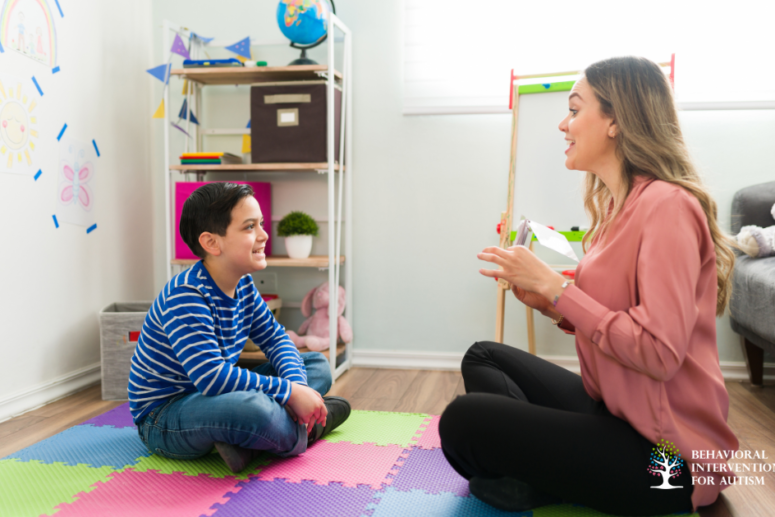
Table of Contents
Applied Behavior Analysis (ABA) is a therapeutic approach rooted in behavioral science, widely recognized for its effectiveness in treating individuals with autism spectrum disorder (ASD) and other developmental conditions.
A critical area of focus within ABA is speech therapy, which aims to enhance communication skills. This article delves into the techniques used in ABA speech therapy and explores how these methods contribute to improving speech and language abilities.
ABA Speech Therapy Principles
ABA speech therapy techniques are grounded in the principles of behavior analysis, which involve understanding and modifying behavior through positive reinforcement, prompting, and systematic instruction.
ABA Speech Therapy Principles
These techniques are tailored to meet the unique needs of each individual, making them highly effective in promoting communication skills. Below are some of the most commonly used techniques in ABA speech therapy:
Discrete Trial Training (DTT)
Discrete Trial Training (DTT) is a teaching approach that breaks down skills into smaller, manageable components. Each component, or “discrete trial,” involves a clear beginning and end, allowing the therapist to provide immediate feedback and reinforcement. DTT is particularly effective for teaching new skills and can be used to target specific speech and language goals.
Key Features of DTT:
- Clear Instructions: The therapist presents a clear, concise instruction or question.
- Immediate Response: The child is given a brief moment to respond.
- Immediate Reinforcement: Positive reinforcement is provided immediately based on the accuracy of the response.
- Data Collection: Progress is monitored and recorded to adjust the teaching plan as needed.
Natural Environment Teaching (NET)
Natural Environment Teaching (NET) focuses on learning in natural, everyday contexts rather than in a structured, clinical setting. This approach aims to promote the generalization of skills by encouraging children to use their communication abilities in real-life situations. NET leverages the child’s interests and natural motivations to create meaningful learning opportunities.
Key Features of NET:
- Child-Centered: Activities are based on the child’s interests.
- Contextual Learning: Skills are taught within the context of natural, everyday activities.
- Generalization: Promotes using learned skills in various settings and with different people.
- Flexible Structure: Less rigid than DTT, allowing for spontaneous learning moments.
Pivotal Response Treatment (PRT)
Pivotal Response Treatment (PRT) is an evidence-based intervention that targets “pivotal” areas of development, such as motivation and response to multiple cues. By focusing on these key areas, PRT aims to improve communication, social skills, and behavior.
Key Features of PRT:
- Child Choice: Children are allowed to choose activities and items of interest.
- Reinforcement of Attempts: Any attempt to communicate is reinforced, not just correct responses.
- Natural Consequences: Reinforcement is naturally tied to the child’s actions (e.g., asking for a toy results in getting the toy).
- Motivation: Emphasizes enhancing motivation to learn and interact.
Verbal Behavior Therapy (VBT)
Verbal Behavior Therapy (VBT) is a specialized form of ABA that focuses on teaching language through the analysis of verbal behavior. VBT is based on the idea that language can be broken down into different functions, such as requesting (mand), labeling (tact), and repeating (echoic).
Key Features of VBT:
- Functional Analysis: Language is broken down into functional units.
- Mand Training: Focus on teaching requests to fulfill needs and wants.
- Tact Training: Teaching labeling of objects, actions, and events.
- Echoic Training: Reinforcing repetition of words and sounds.
- Reinforcement: Immediate reinforcement for correct responses to strengthen verbal behavior.
Picture Exchange Communication System (PECS)
The Picture Exchange Communication System (PECS) is a widely used augmentative and alternative communication (AAC) system designed to help nonverbal individuals develop functional communication skills. PECS involves using pictures or symbols to communicate needs and desires.
Key Features of PECS:
- Phase-Based Training: Starts with basic exchanges and progresses to complex sentence structures.
- Visual Communication: Utilizes pictures and symbols to facilitate communication.
- Functional Use: Promotes spontaneous communication in natural settings.
- Independence: Aims to reduce dependence on prompts by encouraging independent communication.
Prompting and Fading
Prompting is a technique used to encourage the desired response by providing additional cues or assistance. Prompts can be verbal, gestural, or physical, depending on the individual’s needs and the complexity of the task. Fading involves the gradual removal of prompts as the individual becomes more proficient in the skill.
Key Features of Prompting and Fading:
- Types of Prompts: Verbal (e.g., saying “Say ‘please’”), gestural (e.g., pointing), and physical (e.g., guiding hand movements).
- Hierarchy of Prompts: Starting with the most intrusive and gradually moving to less intrusive prompts.
- Systematic Fading: Gradual reduction of prompts to encourage independent performance.
- Reinforcement: Continuous reinforcement to strengthen the behavior during the fading process.
Reinforcement
Reinforcement is a fundamental component of ABA therapy, used to increase the likelihood of desired behaviors. Positive reinforcement involves providing a reward or positive consequence following the desired behavior, which strengthens the behavior and encourages its recurrence.
Key Features of Reinforcement:
- Positive Reinforcement: Providing rewards such as praise, toys, or activities.
- Individualized Reinforcers: Tailored to the individual’s preferences and motivations.
- Immediate Reinforcement: Delivered immediately following the desired behavior.
- Consistency: Consistent application to build and maintain desired behaviors.
Shaping
Shaping involves reinforcing successive approximations of a target behavior until the desired behavior is achieved. This technique is particularly useful for teaching new or complex skills that the individual may not be able to perform initially.
Key Features of Shaping:
- Incremental Steps: Breaking down the target behavior into smaller, manageable steps.
- Successive Approximations: Reinforcing closer and closer approximations to the desired behavior.
- Flexibility: Adjusting the criteria for reinforcement based on the individual’s progress.
- Positive Reinforcement: Continuous reinforcement to encourage progress.
Generalization
Generalization refers to the ability to apply learned skills across different contexts, people, and situations. In ABA speech therapy, promoting generalization is crucial to ensure that communication skills are not limited to the therapy setting.
Key Features of Generalization:
- Multiple Settings: Practicing skills in various environments such as home, school, and community.
- Different People: Involving different communication partners like parents, teachers, and peers.
- Variety of Contexts: Encouraging the use of skills in different activities and situations.
- Maintenance: Regular practice to ensure skills are retained and generalized over time.
The Role of Parents and Caregivers
Parents and caregivers play a crucial role in the success of ABA speech therapy. Their involvement is essential in reinforcing learned skills and promoting generalization across different environments. Here are some ways they can support the therapy process:
Collaboration with Therapists
Effective communication and collaboration with therapists ensure consistency in the application of techniques. Regular meetings and updates help align strategies used at home with those in therapy sessions.
Home Practice
Incorporating therapy techniques into daily routines at home reinforces learning and helps generalize skills. Parents can practice language skills during meals, playtime, and other daily activities.
Positive Reinforcement
Using positive reinforcement at home encourages desired behaviors and communication skills. Parents should identify effective reinforcers and apply them consistently to support their child’s progress.
Monitoring Progress
Keeping track of the child’s progress helps in making necessary adjustments to the therapy plan. Parents can maintain a log of new skills, challenges, and successes to share with the therapist.
Conclusion
ABA speech therapy techniques offer a comprehensive and individualized approach to enhancing communication skills for individuals with autism and other developmental conditions. By leveraging principles of behavior analysis, these techniques provide structured, evidence-based interventions that promote meaningful progress in speech and language development.
Whether through Discrete Trial Training, Natural Environment Teaching, Pivotal Response Treatment, or other methods, ABA speech therapy aims to empower individuals to communicate effectively and improve their overall quality of life.
The involvement of parents and caregivers further enhances the effectiveness of these techniques, ensuring that gains made in therapy are maintained and generalized across various settings. For those seeking ABA therapy in Florida, Behavioral Intervention for Autism offers specialized services designed to meet your needs. Contact us today to learn more or book a session.
Sources:
https://www.autismparentingmagazine.com/aba-techniques-adaptations/
https://online.regiscollege.edu/blog/aba-and-speech-therapy/
- 9 Common Obsessions of Children With Autism You Should Know - February 25, 2025
- What is Neurodiversity? A Guide to Embracing Differences - February 25, 2025
- Understanding Hyperfocus in Autism: What It Means and Why It Happens - February 25, 2025





